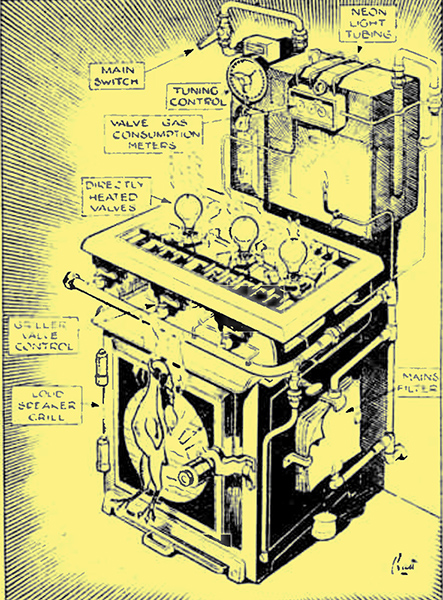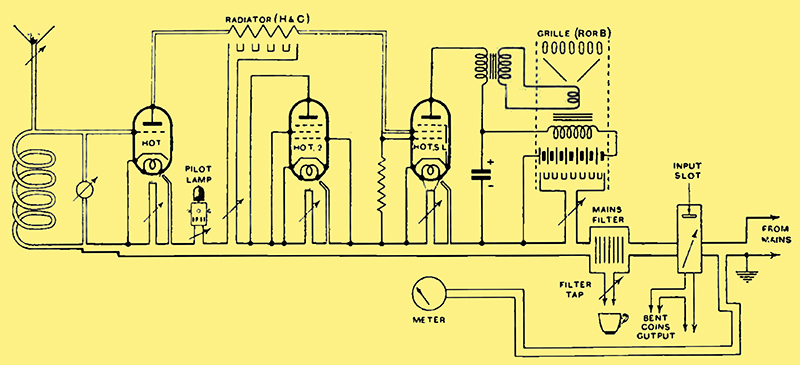|
An ambitious design to provide mains performance where no electric light supply is available.

Domestic utility has been the keynote of the designer's effort in producing this revolutionary instrument.
The applicability of mains driven receivers to AC and DC mains only has for long been an admitted weakness of the type. Statistics have been brought forward to show that for every householder who is connected to AC or DC there are several who are not, and who are in consequence deprived of being able to make effective use of mains-driven sets, even if they have bought them. Our enterprising radio industry has fulfilled the expectations we have so often exclusively expressed in these pages, and the Thermo Superjet Three brings the benefits hitherto enjoyed by AC and DC consumers to the millions who are connected to gas mains only.
It might be supposed that the designer would impose severe limitations on himself in undertaking a task of this nature; but in the instance of the present receiver he has contrived to introduce a number of important advantages, which will no doubt lead to many all-electric homes being piped for gas at an early date. The valves are all of the gas-filled type, and have a slope of 5 milliamps per therm. They are directly heated - and so, for the matter of that, is the whole receiver - being provided with incandescent burners at the base. As usual, these are fitted with by-passes, the by-pass capacitors having a capacity of 0.005 cubic ft. A pilot light is also fitted, which serves the dual purpose of illuminating the tuning scale and casting a subdued but quite adequate radiance over the whole room. A variety of artistic shades can be obtained to suit most of the less usual decorative schemes.
The power pack consists of a gas-ring and multiple thermocouple assembly, and this should be lit well in advance of any desired programme. A gas-meter, operating on the push-pull principle, is a feature of special interest to the more technical enthusiasts. The increased consumption when political talks are being broadcast can be readily observed.
The thoroughness with which the design has been carried out may be gauged from the fact that the wiring is done entirely with gas-filled tubes of the type used for illuminated advertisements, and the different circuits can be identified with the utmost ease by the colour-code that has been standardised by the RMA. The location of any fault can thus be seen at at a glance, which greatly simplifies servicing. Though this might seem to render skilled servicemen unnecessary, the manufacturers have made assurance doubly sure by equipping selected plumbers in each district throughout the country with a complete kit of tools for dealing with any fault. It is understood, also, that gas inspectors have been instructed to encourage the use of these receivers by making themselves as helpful as possible, and are to be provided with portable wave-meters and calibration charts. It is also understood that a small gas-producer plant is shortly to be marketed for the benefit of those who are not yet piped.
The difficulties so common in soldered connections, due to dry joints, have been entirely overcome; and in fact wiped joints are used throughout. A mains filter has also been incorporated, consisting of six stages of blotting paper connected in series, with the object of removing every trace of moisture introduced by the mains, and so reducing the damping of the tuned circuits.
An Unusual Cabinet
The cabinet is made of cast iron about three inches thick, and is artistically finished in dull black, which has the additional merit of aiding the dissipation of the considerable amount of heat that is given off. This heat would hitherto have been considered a disadvantage, but in this model it has ingeniously been made possible to roast a joint or poultry during reception of the hotter types of dance music by hanging them on a hook provided in front of the loud speaker grille. This gives rise to occasional frying noises, which are not really serious however.
The controls consist of a main on-off tap, with shilling-in-the-slot input circuit, a roast-or-boil switch, and an automatic smell control. Until the taps are turned on, the smell is barely perceptible with the nose two yards from the loud speaker.
An example of the extraordinary attention to detail is the variable-mew valve to prevent mice from nesting in the gas-meter. As cats are not favoured in Germany, sets exported to that country make use, instead, of the well-known Barkhausen effect.
It should be mentioned that six yards of flexible hose are included with each receiver, which should therefore be of some use, even in the most unfavourable localities.
The set was tested on an indoor aerial five miles from the Gas Bright and Choke Co's works, at first on a lighting circuit. As there were symptoms of low tension, the connection was transferred to a higher pressure supply by displacing the gas cooker. Because the Model No. EL rendered the cooker redundant, no harm resulted.
Apart from a good deal of hiss, reception was at first rather poor, but after investigating the fault with the aid of a pocket cigarette-lighter, the whole affair blew up with a loud report, followed by a complete fade-out. The test had therefore to be abandoned at this point, but there is no difficulty in declaring the performance to be outstanding in every direction. The power output was more than adequate for domestic purposes, and the programme was of definite entertainment value to listeners situated at a considerable distance. Reproduction was well forward, with strongly marked transients. It is true that there was a certain amount of break-through, together with side-band cutting, but these were not noticed at the time.
We have hesitated in the past to apply the adjective sensational to any receiver that has passed through our hands, but as the one at present being reviewed nearly passed through our face as well it would be hypercritical to withhold that description any longer.
Features
- Type. - General purpose receiver for gas mains only, incorporating almost everything.
- Circuit. - Variable-mew gas-filled valves coupled by neon-tubes. No rectifier needed.
- Controls:
- On-of tap, with shilling-in-the-slot orifice.
- Roast-or-boil switch.
- Automatic smell control.
- Rent. - 11½d. per quarter.
- Makers. - The Gas Bright and Choke C0., Ltd.

As this diagram shows, the circuit is far from being conventional, many quite unusual features having been incorporated.
NOTE. - As our usual set reviewer is on his Christmas holidays, the feature is supplied this week by our contributor, Mr M G Scroggie. We therefore ask the indulgence of our readers in the event of any errors having been included.
|